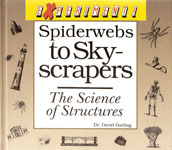SPIDERWEBS TO SKYSCRAPERS: The Science of Structures - 4. Sky High
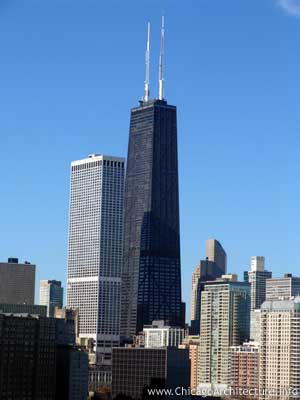
Figure 1. The John Hancock Center.
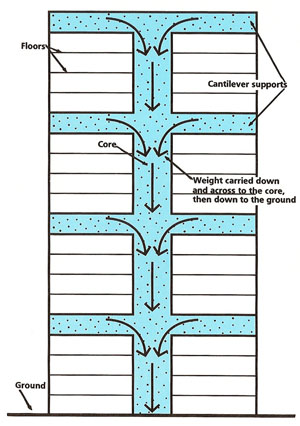
Figure 2. Cantilevers connected to a central core support the great weight of some skyscrapers.
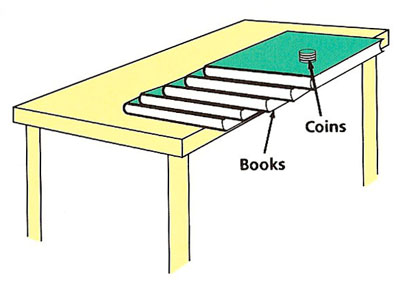
Figure 3. Experiment with cantilevers.
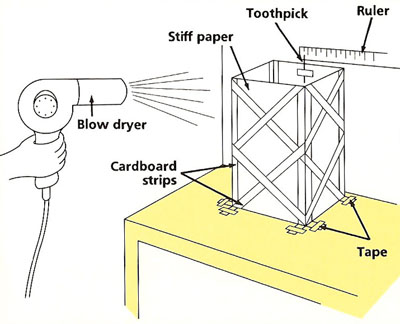
Figure 4. Skyscraper wind test.

Figure 5. Tall skyscrapers may sway as much as 3 feet in a strong wind.
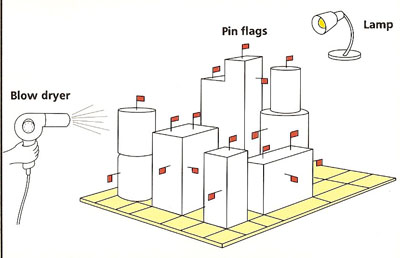
Figure 6. Model city.
Tall structures are the best-known and most spectacular human-made landmarks in the world. From the Great Pyramid of Cheops in Egypt to the Empire State Building in New York City, they impress anyone who looks at them.
But tall buildings also serve an important practical purpose today. By spreading upward instead of outward, a skyscraper makes the best possible use of limited space in the center of a city.
For example, the 100-story John Hancock Building in Chicago provides homes for 1,500 people and work space for a further 3,500 (see Figire 1). A restaurant one thousand feet above the ground and a swimming pool and grocery store on the forty-fourth floor are among its other sky-high facilities.
A Pressing Problem
Weight is the biggest problem in the construction of high buildings. The load on the lower sections of a very tall building is only slightly less than that of the foundations. For this reason, the top section of a skyscraper must be made of lighter materials. Most multistory buildings have frames consisting of steel girders that become thinner toward the top.
As with all structures, a skyscraper must be designed so that the weight of the upper parts is properly supported by the parts underneath. One way to do this is to build a very strong central "core," like the trunk of a tree. The floors of the building are then held up by powerful arching beams, known as cantilevers, that stick out from this core like a tree's branches (see Figure 2).
High Winds Beyond this Point
After weight, the next greatest force acting on a tall structure is the pressure of moving air. Winds tend to blow much harder on the upper floors of a skyscraper than on those lower down. As a result, there is a powerful bending force on the base.
To resist wind pressure and prevent the top of a building from moving too much, thick steel beams are used to stiffen the outer walls. These may consist of heavy beams that run right across and around the skyscraper or diagonal beams that make an X-shaped pattern. Diagonal beams were originally used to stiffen just the central core of tall buildings, but now they are also found on the outside walls.
Another way to reduce sway is to make a skyscraper narrower at the top than at the bottom. This lessens the area of the walls where the wind speeds are highest, so that the sideways force on the top parts of the building is lowered.
Even the strongest skyscrapers, however, sway to some extent. The wind force acting over one face of a tall building may be as much as two thousand tons. This can cause the top of a building to sway back and forth by as much as three feet.

Hanging in MidairYou will need:
What to do:
Arrange the books as shown in the diagram. The table represents the core of a skyscraper. The books represent a cantilever, jutting out from the core, supporting the floors of the building. Place several coins at the edge of the top book of the cantilever. These represent the weight of the floors the cantilever has to support (see Figure 3). What happens? If the cantilever is not strong enough, reduce the stagger of the books until they can support their load. Notice the type of curve the projecting ends of the books make.
Try arranging the books in a different way so that they stick out as much as the cantilever and support the same load. Is this possible?
Taking it further:
Try doing the experiment with arches of different heights (keeping the gap between the books the same). Which shape of arch is the strongest? |

Swaying in the WindYou will need:
What to do:
Make a model skyscraper as shown in the diagram. Cut fur strips of cardboard each 25" long and 2' wide. Draw a line down the middle of each strip, then score and bend the cardboard along this line. Make a cut 1" long from one end of the line and fold out the two flaps. Glue the sheets of paper to the strips of cardboard to make the structure as shown. Tape the cardboard flaps securely to the table so that one side of the model is almost up against the wall. Tape the toothpick into the right-hand corner of the cardboard frame that is against the wall so that it sticks up at least 1" from the top of the model. Tape one of the rulers to the wall so that the toothpick is pointing at the zero end of the scale. Hold the blow dryer one foot from the top of the left-hand wall and turn it on to the coolest, highest-speed setting (see Figure 4). Notice what happens to the model skyscraper. Record how far the toothpick has moved from its zero setting. This gives a measure of the sway of your structure.
Now try adding the X-shaped cardboard supports. Glue these securely to each side of the model. Position the blow dryer as before, turn it the same setting, and measure the amount of sway. What do you conclude?
Taking it further:
Experiment with your own methods to reduce the sway in your model skyscraper. For example, try adding extra strips of cardboard to stiffen the structure or devise ways to make the lower sections of the model heavier than the top. You might also look at how the shape of a structure affects the amount it sways. For example, try testing a structure that tapers toward the top.
It is important in this experiment that the attachment of the model skyscraper to the table, or other surface, be very secure. Otherwise, the measurement will include some "give" of the base as well as bending of the whole structure. If the tape does not prevent the bottom of the structure from lifting away in the airstream then the arrangement is not a fair one. This is because it would be allowing an uncontrolled factor to interfere with the quantity under investigation – namely, the bending of the model skyscraper in the artificial wind.
As with all the experiments described on these pages, the method given is only a suggestion. You should try out your own ideas and modifications. Perhaps you can devise a batter way of building the skyscraper or measuring the amount of swaying.
Try making models of famous skyscraper such as the Sears Tower or John Hancock Center in Chicago, or the Empire State Building in New York. Remember, however, that this will not give a fair comparison of the amount of sway in these buildings since you will not have taken into account differences in internal structure, weight distribution, and so on. |
Safety Checks
The design of a new skyscraper has to be thoroughly tested to make sure that it can stand up to all the forces that will act on it (see Figure 5). To determine the effect of winds, for example, a plastic scale model may be built that has small tubes with openings at various heights. This model is then put in front of a set of powerful fans. As the moving air from the fans strikes the model, the amount by which the air pressure in the tubes is increased can be measured. If the bending force of the wind seems too high then the design may have to be altered, perhaps by adding more steel beams. Sometimes a model will be made of the entire downtown area of a city. This is because the winds acting on a new building will be determined partly by the position and size of other skyscrapers nearby.
Much use is also made of computers in the early stages of skyscraper design. Programs running on a computer help to show how important parts of the design are affected by the loads they have to bear. The computer can produce color pictures highlighting regions where the force is most intense.
In some parts of the world, earthquakes are a threat – especially to tall buildings that might easily topple over. Skyscrapers in places such as San Francisco need to have special foundations that can absorb the shock of earthquakes. They also need to have supporting frameworks that can bend and vibrate without giving way. Special equipment known as a "shaking table" allows engineers to test whether a new design would be safe in an earthquake.

A Model CityYou will need:
What to do:
Stick the containers to the base to make a model of the city. Make the model realistic by drawing out a street plan and arranging the buildings in well laid out blocks.
Cut small strips of paper and fold them around the pins to make little flags. The paper should be able to spin around freely if you blow on it. Stick the flags on various parts of your model – at street level and on the tops and sides of the buildings.
Set up the fan so that it is level and pointing at the tops of your model skyscrapers. Turn all the flags so that they are at right angles to the direction the fan is pointing (see Figure 6). Turn on the fan. What happens to the flags? Which parts of the city have felt the greatest effect of the wind? Move the fan to a new position, set up the flags as before, and repeat the experiment. Describe your results.
Darken the room and use the lamp or flashlight to represent the sun. Move the light over the model in a high arc. Notice how the shadows of the buildings move and change size. Do any of the shadows of the taller buildings extend beyond the downtown area? If so, these shadows might fall on parts of the city where many people have their homes. Decide if this is a problem and, if so, redesign your model to reduce the effects of shadowing.
Taking it further:
Invent your own section of a city or use ideas from a city that you know well. You might also study the effects, for example, of demolishing one of the skyscrapers in your model and replacing it by a much higher one.
Instead of an entire section of a city, you could focus on just a small cluster of skyscrapers. One of the effects of tall buildings is that they tend to cause winds to spiral down to street level. You could study this by putting several high structures together, marking their sides and the model streets with pin flags, and then directing air from a powerful fan at the tops of the buildings. Can you produce a spiraling air pattern? If so, can you get rid of the wind at street level by rearranging the buildings or spacing them farther apart? Read about this effect and find out how architects attempt to avoid the problem in practice. |

